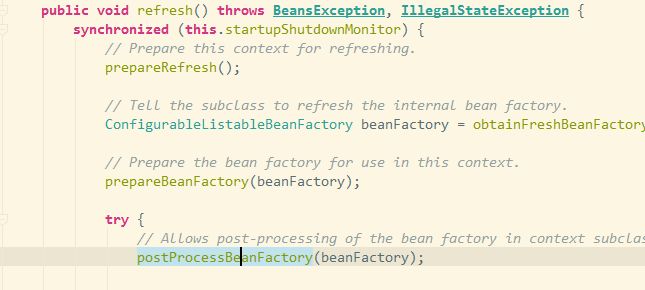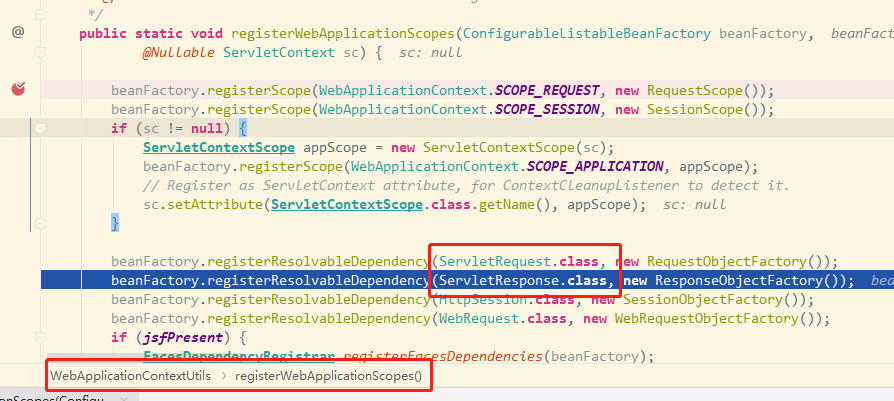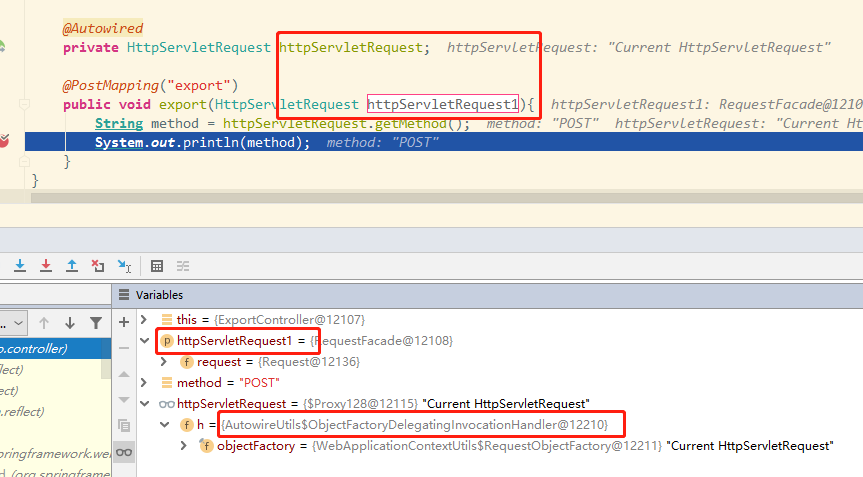1.现象
众所周知,在spring的bean中使用HttpServletRequest可以使用
@Autowired
protected HttpServletRequest request;
或者在controller的方法入参中加入HttpServletRequest
public void exportOrder(HttpServletRequest request) {
return null;
}
但是为什么可以这样使用?controller类默认是单例的,使用@Autowired注入的response和request却可以在多个线程中使用,这就出现了作用域request级别的bean注入到singleton级别的bean中去的现象。
那么spring是如何保证在singleton作用域中使用更长作用域的bean的呢?
2.spring如何注入作用域不同的bean
在此文中说明了spring中,如果需要将作用域较大的bean A注入较小的bean B中时,其实注入的是A的代理对象,在需要时使用代理getObject()来获取一些指定的依赖。
3.HttpServletRequest如何初始化
在controller中使用HttpServletRequest时,我们并不需要注入就可以使用。这是因为spring初始化的过程中,就已经把HttpServletRequest注册到容器中去了。通过spring的refresh()方法的postProcessBeanFactory(beanFactory),
该方法实现的ServletWebServerApplicationContext的postProcessBeanFactory调用了WebApplicationContextUtils.registerWebApplicationScopes()
4.HttpServletRequest的使用
那么知道了是如何注入之后,那么又是如何使用的呢。使用一个例子来看一看:
/**
* @author LWong
* @date 2020/04/23
*/
@RestController("req")
public class ExportController {
@Autowired
private HttpServletRequest httpServletRequest;
@PostMapping("export")
public void export(HttpServletRequest httpServletRequest1){
String method = httpServletRequest.getMethod();
System.out.println(method);
}
}
分别在方法入参和controller中引用HttpServletRequest,打断点查看httpServletRequest和httpServletRequest1
在图片中可以发现httpServletRequest是一个代理对象是,作为成员变量注入的时候注入的是代理对象,AutowireUtils.ObjectFactoryDelegatingInvocationHandler的实例,而作为方法参数注入的就是我们一般使用的Request对象。那么来看看这个handler
/**
* Reflective {@link InvocationHandler} for lazy access to the current target object.
*/
@SuppressWarnings("serial")
private static class ObjectFactoryDelegatingInvocationHandler implements InvocationHandler, Serializable {
private final ObjectFactory<?> objectFactory;
public ObjectFactoryDelegatingInvocationHandler(ObjectFactory<?> objectFactory) {
this.objectFactory = objectFactory;
}
@Override
public Object invoke(Object proxy, Method method, Object[] args) throws Throwable {
String methodName = method.getName();
if (methodName.equals("equals")) {
// Only consider equal when proxies are identical.
return (proxy == args[0]);
}
else if (methodName.equals("hashCode")) {
// Use hashCode of proxy.
return System.identityHashCode(proxy);
}
else if (methodName.equals("toString")) {
return this.objectFactory.toString();
}
try {
return method.invoke(this.objectFactory.getObject(), args);
}
catch (InvocationTargetException ex) {
throw ex.getTargetException();
}
}
}
通过this.objectFactory.getObject()方法进入到WebApplicationContextUtils.currentRequestAttributes()
从这个又要进入RequestContextHolder的getRequestAttributes方法
而requestAttributesHolder正是初始化的threadLocal,保证了线程安全
看到这里答案已经很明了了,这个RequestContextHolder的ThreadLocal成员变量就是实现的关键所在,它存放了每个线程对应的Request对象,因此在@Controller中调用作为成员变量注入的代理类的方法时,最终可以取到当前线程相对应的Request对象,并调用Request对应的方法,这样@Controller中的成员变量不需要重复注入(它一直都是最初bean初始化时注入的代理类),也避免了线程不安全的问题。
5.总结
1、 在bean中注入作为成员变量的HttpServletRequest时,实际注入的是spring框架生成的代理对象,是ObjectFactoryDelegatingInvocationHandler的实例。在我们调用这个成员变量的方法时,最终是调用了objectFactory的getObject()对象的对应方法,在这里objectFactory是RequestObjectFactory这个类的对象。
2、 RequestObjectFactory的getObject方法是从RequestContextHolder的threadlocal中去取值的。





